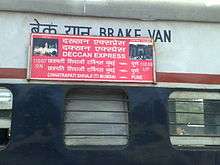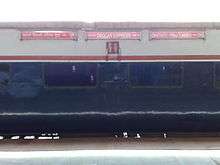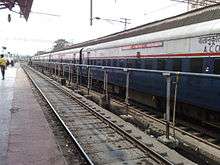Deccan Express
| Overview | |
|---|---|
| Service type | Superfast Express |
| Current operator(s) | Central Railways |
| Route | |
| Start | Mumbai CST |
| Stops | 12 as 11007 Deccan Express, 11 as Deccan Express |
| End | Pune |
| Distance travelled | 192 km (119 mi) |
| Average journey time | 4 hours 5 minutes |
| Service frequency | daily |
| Train number(s) | 11007 / 11008 |
| On-board services | |
| Class(es) | AC Chair Car, Second Class sitting |
| Seating arrangements | Yes |
| Sleeping arrangements | No |
| Catering facilities | No Pantry Car |
| Technical | |
| Track gauge | 1,676 mm (5 ft 6 in) |
| Operating speed |
100 km/h (62 mph) maximum 46 km/h (29 mph), including halts |
The Deccan Express (Marathi: डेक्कन एक्स्प्रेस) is an express train that leaves daily at 3:30pm,[1] plying between the cities of Pune and Mumbai in India, a distance of 192 km.




Services
The train is operated by Indian Railways, coming under the Central Railway zone and it is one of the six point-to-point express trains which carry thousands of passengers daily between Pune and Mumbai. The other five being the Sinhagad Express, Pragati Express, Deccan Queen, Indrayani Express and Intercity Express.
Deccan Express is named from Deccan Plateau where Pune city is located.[2]
Traction
This train is hauled end to end by a Kalyan based WCAM 3.
Timetable
The 11007 Deccan Express leaves Mumbai CST at 7 am and arrives at Pune Junction at 11:05 am. While on the return journey, the 11008 Deccan Express leaves Pune at 15:30 and reaches CSTM at 19:40.[3][4]
| Station Code |
Station Name | 11007[5] | 11008 | ||||
|---|---|---|---|---|---|---|---|
| Arrival | Departure | Distance in km |
Arrival | Departure | Distance in km | ||
| CSTM | Mumbai CST | Source | 07:00 | 0 | 19:40 | Destination | 192 |
| DR | Dadar | 07:13 | 07:15 | 9 | 19:13 | 19:15 | 183 |
| TNA | Thane | 07:34 | 07:35 | 33 | 18:43 | 18:45 | 159 |
| KYN | Kalyan | 07:57 | 08:00 | 53 | 18:20 | 18:25 | 139 |
| NRL | Neral | 08:29 | 08:30 | 86 | - | - | - |
| KJT | Karjat | 08:49 | 08:50 | 100 | 17:28 | 17:30 | 92 |
| KAD | Khandala | 09:30 | 09:32 | 125 | 16:43 | 16:45 | 67 |
| LNL | Lonavla | 09:38 | 09:40 | 129 | 16:33 | 16:35 | 63 |
| TGN | Talegaon | 10:09 | 10:10 | 158 | 16:06 | 16:08 | 34 |
| KK | Khadki | 10:45 | 10:46 | 186 | 15:42 | 15:45 | 6 |
| SVJR | Shivajinagar | 10:50 | 10:51 | 190 | 15:35 | 15:38 | 2 |
| PUNE | Pune | 11:05 | Destination | 192 | Source | 15:30 | 0 |
History
Throughout history of railways in India the Deccan Queen is one of the most popular trains in India. The Deccan Queen, started on 1 June 1930 was the fastest and most luxurious train on the Mumbai - Pune section. Before introduction of the Deccan Queen, Poona Mail was the most luxurious train on this route. Initially the train was owned and operated by Great Indian Peninsula Railway and transferred to Indian Railways after merging of Great Indian Peninsula Railway in Indian Railways. This train used to travel the Mumbai-Pune distance in 2 hours 45 minutes. However, due to increase in suburban traffic the travelling time has increased to 3 hours 15 minutes. This train was served with a pantry car since it was introduced. The train made its first run from Kalyan to Pune and was just a seven bogie train. However the train was later increased till Mumbai CST (formally Victory Terminus). The train today hauls 17 bogies along with two guard vans with total of 19 bogies. This train was attached with double deck compartments in 1980s. Initially the train was hauled by EA1 (WCP 1 locomotive) when it was introduced. Later by 1970s the train was hauled by WCM 2 or WCM 4 locomotives. Today it hauled by WCAM 3/2p locomotive. The Poona Mail and the Deccan Queen used to serve Mumbai-Pune commuters for several years together later when the Poona Mail was extended till Kolhapur and was renamed as the Sahyadri Express.[6]
See also
References
- ↑ "Deccan Express (11008)". www.mustseeindia.com. Retrieved 16 December 2012.
- ↑ "The Deccan Plateau". deccanplateau.net. Retrieved 16 December 2012.
- ↑ "Deccan Express/11007". indiarailinfo.com. Retrieved 16 December 2012.
- ↑ "Deccan Express/11008". indiarailinfo.com. Retrieved 16 December 2012.
- ↑ "Indian railways enquiry". Indian Railways.
- ↑ Deccan Queen